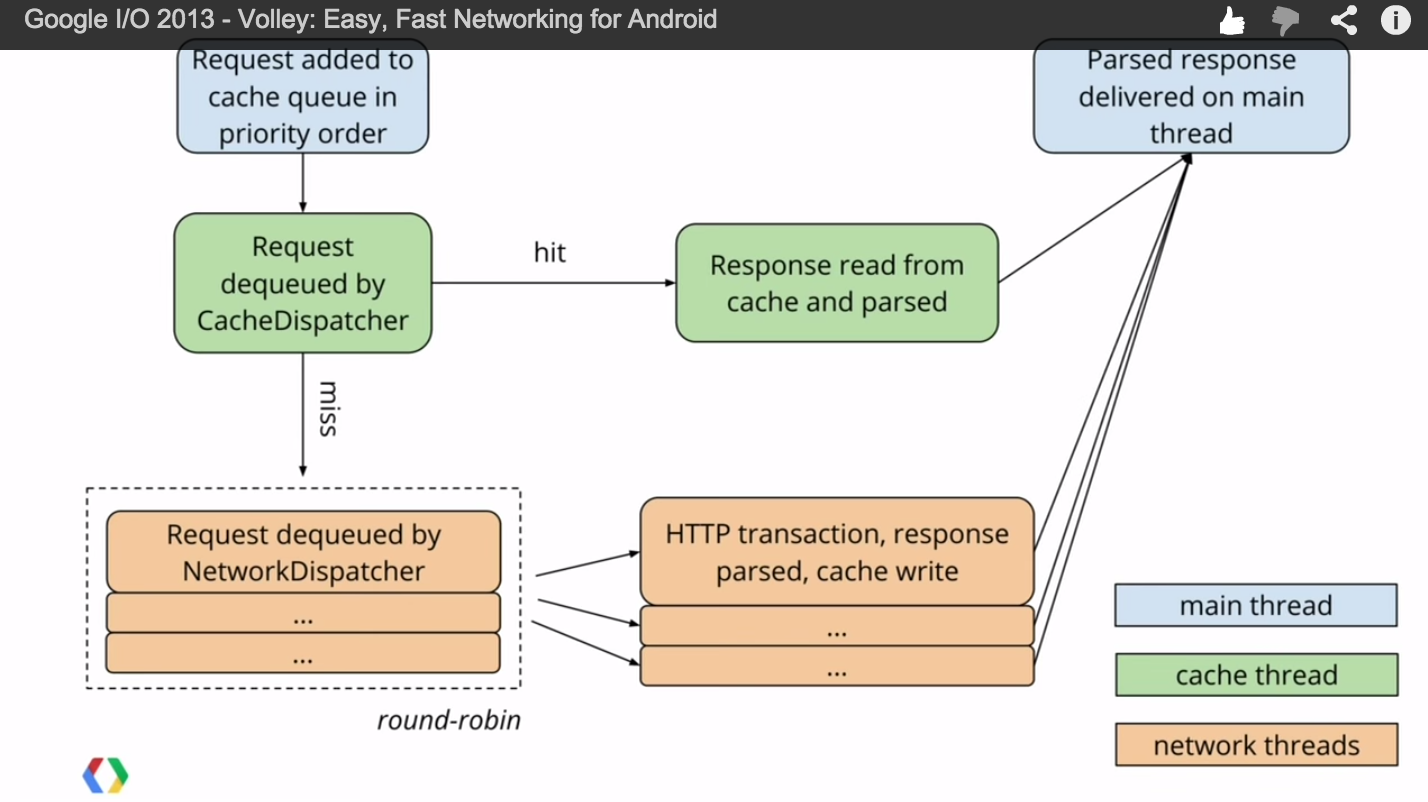Android库Volley的使用介绍
Android Volley 是Google开发的一个网络lib,可以让你更加简单并且快速的访问网络数据。Volley库的网络请求都是异步的,你不必担心异步处理问题。
Volley的优点:
- 请求队列和请求优先级
- 请求Cache和内存管理
- 扩展性性强
- 可以取消请求
##下载和编译volley.jar
- 需要安装git,ant,android sdk
clone代码:git clone https://android.googlesource.com/platform/frameworks/volley
- 编译jar:
android update project -p . ant jar
添加volley.jar到你的项目中
不过已经有人将volley的代码放到github上了:
https://github.com/mcxiaoke/android-volley,你可以使用更加简单的方式来使用volley:
###Maven
format: jar
<dependency>
<groupId>com.mcxiaoke.volley</groupId>
<artifactId>library</artifactId>
<version>1.0.6</version>
</dependency>
###Gradle
format: jar
compile 'com.mcxiaoke.volley:library:1.0.6'
##Volley工作原理图
##创建Volley 单例
使用volley时,必须要创建一个请求队列RequestQueue,使用请求队列的最佳方式就是将它做成一个单例,整个app使用这么一个请求队列。
public class AppController extends Application {
public static final String TAG = AppController.class
.getSimpleName();
private RequestQueue mRequestQueue;
private ImageLoader mImageLoader;
private static AppController mInstance;
@Override
public void onCreate() {
super.onCreate();
mInstance = this;
}
public static synchronized AppController getInstance() {
return mInstance;
}
public RequestQueue getRequestQueue() {
if (mRequestQueue == null) {
mRequestQueue = Volley.newRequestQueue(getApplicationContext());
}
return mRequestQueue;
}
public ImageLoader getImageLoader() {
getRequestQueue();
if (mImageLoader == null) {
mImageLoader = new ImageLoader(this.mRequestQueue,
new LruBitmapCache());
}
return this.mImageLoader;
}
public <T> void addToRequestQueue(Request<T> req, String tag) {
req.setTag(TextUtils.isEmpty(tag) ? TAG : tag);
getRequestQueue().add(req);
}
public <T> void addToRequestQueue(Request<T> req) {
req.setTag(TAG);
getRequestQueue().add(req);
}
public void cancelPendingRequests(Object tag) {
if (mRequestQueue != null) {
mRequestQueue.cancelAll(tag);
}
}
}
另外,你还需要一个Cache来存放请求的图片:
public class LruBitmapCache extends LruCache<String, Bitmap> implement ImageCache {
public static int getDefaultLruCacheSize() {
final int maxMemory = (int) (Runtime.getRuntime().maxMemory() / 1024);
final int cacheSize = maxMemory / 8;
return cacheSize;
}
public LruBitmapCache() {
this(getDefaultLruCacheSize());
}
public LruBitmapCache(int sizeInKiloBytes) {
super(sizeInKiloBytes);
}
@Override
protected int sizeOf(String key, Bitmap value) {
return value.getRowBytes() * value.getHeight() / 1024;
}
@Override
public Bitmap getBitmap(String url) {
return get(url);
}
@Override
public void putBitmap(String url, Bitmap bitmap) {
put(url, bitmap);
}
}
别忘记在AndroidManifest.xml文件中添加android.permission.INTERNET权限。
##创建Json请求
volley自带了JsonObjectRequest和JsonArrayRequest分别来处理Json对象请求和Json数据请求(但是voley没有使用gson库写一个GsonRequest,发送一个request,volley直接返回一个java对象,不过我们可以自己写)。
###创建json object请求
发送一个请求只要这么简单,创建一个JsonRequest对象,写好response回调接口,并把这个请求放到请求队列中就可以了。JsonArrayRequest也类似。
String tag_json_obj = "json_obj_req";
String url = "http://api.androidhive.info/volley/person_object.json";
JsonObjectRequest jsonObjReq = new JsonObjectRequest(Method.GET,url, null,
new Response.Listener<JSONObject>() {
@Override
public void onResponse(JSONObject response) {
Log.d(TAG, response.toString());
}
}, new Response.ErrorListener() {
@Override
public void onErrorResponse(VolleyError error) {
VolleyLog.d(TAG, "Error: " + error.getMessage());
}
});
AppController.getInstance().addToRequestQueue(jsonObjReq, tag_json_obj);
创建String请求
StringRequest可以用来请求任何string类型的数据:json,xml,文本等等。
String tag_string_req = "string_req";
String url = "http://api.androidhive.info/volley/string_response.html";
ProgressDialog pDialog = new ProgressDialog(this);
pDialog.setMessage("Loading...");
pDialog.show();
StringRequest strReq = new StringRequest(Method.GET,
url, new Response.Listener<String>() {
@Override
public void onResponse(String response) {
Log.d(TAG, response.toString());
pDialog.hide();
}
}, new Response.ErrorListener() {
@Override
public void onErrorResponse(VolleyError error) {
VolleyLog.d(TAG, "Error: " + error.getMessage());
pDialog.hide();
}
});
AppController.getInstance().addToRequestQueue(strReq, tag_string_req);
创建POST请求
上面说的都是GET请求,下面来说一下POST请求,与GET请求不同的是,只要在创建请求的时候将请求类型改为POST请求,并且override Request的getParams方法即可。
String tag_json_obj = "json_obj_req";
String url = "http://api.androidhive.info/volley/person_object.json";
ProgressDialog pDialog = new ProgressDialog(this);
pDialog.setMessage("Loading...");
pDialog.show();
JsonObjectRequest jsonObjReq = new JsonObjectRequest(Method.POST,
url, null,
new Response.Listener<JSONObject>() {
@Override
public void onResponse(JSONObject response) {
Log.d(TAG, response.toString());
pDialog.hide();
}
}, new Response.ErrorListener() {
@Override
public void onErrorResponse(VolleyError error) {
VolleyLog.d(TAG, "Error: " + error.getMessage());
pDialog.hide();
}
}) {
@Override
protected Map<String, String> getParams() {
Map<String, String> params = new HashMap<String, String>();
params.put("name", "Androidhive");
params.put("email", "abc@androidhive.info");
params.put("password", "password123");
return params;
}
};
AppController.getInstance().addToRequestQueue(jsonObjReq, tag_json_obj);
##添加请求头部信息
String tag_json_obj = "json_obj_req";
String url = "http://api.androidhive.info/volley/person_object.json";
ProgressDialog pDialog = new ProgressDialog(this);
pDialog.setMessage("Loading...");
pDialog.show();
JsonObjectRequest jsonObjReq = new JsonObjectRequest(Method.POST,url, null,new Response.Listener<JSONObject>() {
@Override
public void onResponse(JSONObject response) {
Log.d(TAG, response.toString());
pDialog.hide();
}
}, new Response.ErrorListener() {
@Override
public void onErrorResponse(VolleyError error) {
VolleyLog.d(TAG, "Error: " + error.getMessage());
pDialog.hide();
}
}) {
@Override
public Map<String, String> getHeaders() throws AuthFailureError {
HashMap<String, String> headers = new HashMap<String, String>();
headers.put("Content-Type", "application/json");
headers.put("apiKey", "xxxxxxxxxxxxxxx");
return headers;
}
};
AppController.getInstance().addToRequestQueue(jsonObjReq, tag_json_obj);
##创建Image请求
Volley库中自带了NetworkImageView类,这个ImageView可以自动使用volley下载图片
###用NetworkImageView加载图片
首先,说明一下,加载图片的原理:
NetworkImageView加载图片需要一个ImageLoader和一个图片URL,这个ImageLoader对象需要一个请求队列对象和ImageCahe对象。调用NetworkImageView的setUrl方法后,首先会判断当前ImageView的URL和新传入的URL是否一致,如果相同,就不用再发送http请求了,如果不同,那么就使用ImageLoader对象来发送http请求获取图片。
ImageLoader imageLoader = AppController.getInstance().getImageLoader();
imgNetWorkView.setImageUrl(Const.URL_IMAGE, imageLoader);
加载一个图片只要这么简单~~~
###用ImageView来加载图片
这个过程和NetworkImageView类似
ImageLoader imageLoader = AppController.getInstance().getImageLoader();
imageLoader.get(Const.URL_IMAGE, new ImageListener() {
@Override
public void onErrorResponse(VolleyError error) {
Log.e(TAG, "Image Load Error: " + error.getMessage());
}
@Override
public void onResponse(ImageContainer response, boolean arg1) {
if (response.getBitmap() != null) {
imageView.setImageBitmap(response.getBitmap());
}
}
});
可以再简单一点:
// Loading image with placeholder and error image
imageLoader.get(Const.URL_IMAGE, ImageLoader.getImageListener(imageView, R.drawable.ico_loading, R.drawable.ico_error))
ImageLoader.getImageListener方法中已经写了一个默认的ImageListener了
##Volley Cachevolley中自带了强大的cache机制来管理请求cache,这会减少网络请求次数和用户等待时间。
###从请求Cache中加载请求
Cache cache = AppController.getInstance().getRequestQueue().getCache();
Entry entry = cache.get(url);
if(entry != null){
try {
String data = new String(entry.data, "UTF-8");
} catch (UnsupportedEncodingException e) {
e.printStackTrace();
}
}
}else{
}
###使请求缓存失效失效并不意味这删除,Volley还会继续使用缓存的对象直到从服务器上获取到了新的数据,新的数据会覆盖旧的数据。
AppController.getInstance().getRequestQueue().getCache().invalidate(url, true);
###关闭Cache
如果你想将某一个请求的Cache功能关闭,直接调用Request的setShouldCache()方法就可以:
StringRequest stringReq = new StringRequest(....);
stringReq.setShouldCache(false);
###将某一URL的Cache删除
调用Cache的remove方法可以删除这个URL的cache:
AppController.getInstance().getRequestQueue().getCache().remove(url);
###删除所有的Cache
AppController.getInstance().getRequestQueue().getCache().clear();
##取消请求
在你添加一个请求到请求队列中的时候,你可以发现,addToRequestQueue(request, tag)方法还接受一个tag参数,这个tag就是用来标记某一类请求的,这样就可以取消这个tag的所有请求了:
String tag_json_arry = "json_req";
ApplicationController.getInstance().getRequestQueue().cancelAll("feed_request");
##请求优先级
在创建一个request的时候可以Override Request方法的getPriority方法返回一个优先级,优先级分为:Normal, Low, Immediate, High
private Priority priority = Priority.HIGH;
StringRequest strReq = new StringRequest(Method.GET,
Const.URL_STRING_REQ, new Response.Listener<String>() {
@Override
public void onResponse(String response) {
Log.d(TAG, response.toString());
msgResponse.setText(response.toString());
hideProgressDialog();
}
}, new Response.ErrorListener() {
@Override
public void onErrorResponse(VolleyError error) {
VolleyLog.d(TAG, "Error: " + error.getMessage());
hideProgressDialog();
}
}) {
@Override
public Priority getPriority() {
return priority;
}
};
##Missing! 创建xml请求
就像创建Gson请求一样,你可以自定义一个XMLRequest类来请求xml数据
Android库Volley的使用介绍的更多相关文章
- GitHub 上排名前 100 的 Android 开源库进行简单的介绍
若有任何疑问可通过邮件或微博联系我 项目名称 项目简介 1. react-native 这个是 Facebook 在 React.js Conf 2015 大会上推出的基于 JavaScript 的开 ...
- 我的Android进阶之旅】GitHub 上排名前 100 的 Android 开源库进行简单的介绍
GitHub Android Libraries Top 100 简介 本文转载于:https://github.com/Freelander/Android_Data/blob/master/And ...
- Android网络通信库Volley简介
1. 什么是Volley 在这之前,我们在程序中需要和网络通信的时候,大体使用的东西莫过于AsyncTaskLoader,HttpURLConnection,AsyncTask,HTTPClient( ...
- NDK中android.mk文件的简单介绍和第三方库的调用
先贴一个样例,然后解释一下: LOCAL_PATH:= $(call my-dir) include $(CLEAR_VARS) LOCAL_MODULE := mydjvuapi SRC_FILE_ ...
- Android网络通信库Volley简介(转)
以前反编译过android market,发现里面有用到volley,起这么个名字不知道啥用的,现在才知道主讲者Ficus Kirkpatrick 就是负责开发Google play 的. 看完视频, ...
- android网络请求库volley方法详解
使用volley进行网络请求:需先将volley包导入androidstudio中 File下的Project Structrue,点加号导包 volley网络请求步骤: 1. 创建请求队列 ...
- Android系统性能调优工具介绍
http://blog.csdn.net/innost/article/details/9008691 经作者授权,发表Tieto某青年牛的一篇<程序员>大作. Android系统性能调优 ...
- 今年新鲜出炉的30个流行Android库,你一定需要
作者|Michal Bialas 2017年快过去了,你年初的定的目标都快完成了吗?总结过去三个月内发布的 最新的30 个 Android 库和项目.你一定需要,建议收藏!让你事半功倍 1.Mater ...
- 怎么通过activity里面的一个按钮跳转到另一个fragment(android FragmentTransaction.replace的用法介绍)
即:android FragmentTransaction.replace的用法介绍 Fragment的生命周期和它的宿主Activity密切相关,几乎和宿主Activity的生命周期一致,他们之间最 ...
随机推荐
- hdu----(1402)A * B Problem Plus(FFT模板)
A * B Problem Plus Time Limit: 2000/1000 MS (Java/Others) Memory Limit: 65536/32768 K (Java/Other ...
- iOS 推送全解析
本文旨在对 iOS 推送(以下简称 推送)进行一个完整的剖析,如果你之前对推送一无所知,那么在你认真地阅读了全文后必将变成一个推送老手,你将会对其中的各种细节和原理有充分的理解.以下是 pikacod ...
- target标签对于优化用户体验的作用
最近开始关注target="_blank"标签,是源于对咨询区的采纳工作.帖子内容页是在原页面加载,这样问题就来了,每采纳完一个问题,必须得后退好几次才可以,很不方便.后来按ctr ...
- PLSQL DEVELOPER 连接远程数据库 OCI客户端安装方法
安装使用过PLSQL Dev都知道,要连接数据库,必须配置TNS(Transparence Network Substrate),而直接安装PLSQL Dev 之后,本机是没有Oracle HOME的 ...
- Linux中Matlab保存多个数据到同一个文件当中
% load pyrim % NumTrain = 50; % load machine %NumTrain = 150; % load housing % NumTrain = 300; % loa ...
- SVN clean up问题
问题如截图所示: 解决方法:在根目录clean up,注意把所有的选项都勾上
- 指定socket文件连接mysql
1.利用ps aux |grep mysql 查看--socket 路径 2.创建软连接.创建文件 3.登录成功
- jQuery实现图片延迟加载
html: <img src ="占位图路径" data-original="真实图片路径" /> js: $("img").l ...
- apache日志轮转
apache默认的日志配置为: ErrorLog "logs/error_log" CustomLog "logs/access_log" co ...
- 基于TCP的通信 客户端
#include <WINSOCK2.H> #include <stdio.h> // socket 套接字 #pragma comment (lib,"Ws2_32 ...
